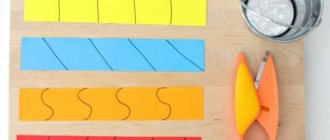In our age of impressive variety of products, the catchphrase “Not all yoghurts are created equal” also applies to toys. It is also true that a lot of toys does not mean “good”.
In this matter, as they say, “less is more”! The pages of this section contain materials on how to choose toys that are useful for a child’s development. Specific recommendations for parents will help them become more responsible when choosing toys for their children. There are also consultations on how best to organize the “communication” of children with toys, in accordance with their developmental and educational functions. Tips for organizing thematic reading competitions.
Let children play not only fun, but also usefully.
Contained in sections:
- Toys 2003
- Consultations for parents 58753
Includes sections:
- Gadgets. Harm and benefit 135
- Home theater. Consultations 79
- Games in the kitchen with children 119
- Lego, LEGO. Consultations and recommendations 147
- What to do with a child. Consultations 737
By groups:
- Junior group
Showing publications 1-10 of 9549. All sections | Toys. Consultations for parents
New
Photo
The best
Advice from a teacher-defectologist “Correctional and developmental games for the perception of individual properties of objects when working with children with disabilities”
Games for the perception of taste. Objectives: to give the child an idea of the four taste standards: sour, sweet, bitter, salty. Show how carefully you need to try unfamiliar foods: with the tip of your tongue, lips, rubbing them on your tongue, “listening”
to your feelings, show...
Consultation “Why speech finger games should be carried out with children” Why speech finger games should be carried out with children” Finger games are the staging of poems and nursery rhymes rhymed with history, fairy tales using fingers. Thanks to finger play, children develop fine motor skills, which in turn stimulates the development of…
Article:
Toys accompany children from the first days of life and are usually considered as means of fun and entertainment. However, we must not forget that they also have a great influence on the physical, mental, communicative and creative development of children. Toys in a child’s life As a rule, the first toys for a child are rattles, rubber rings, various pendants, etc. They are primarily aimed at developing vision, hearing and finger motor skills. Therefore, such toys should be different in shape, texture, color (preferably bright), so that the baby has a desire to look at them, touch them, and pick them up. In the first month after birth, the child develops auditory reactions, so it is important to provide him with several musical toys with different sounds. Thanks to such toys, the baby gradually begins to understand cause-and-effect relationships: when the toy is shaken, it makes sounds. It is important that toys for babies are made of safe and soft materials (preferably rubber, plastic), because the baby will in any case pull them into his mouth and bite. One-year-old babies will be interested in multi-colored plastic cubes, pyramids consisting of several elements, boxes, glasses or bowls of different sizes, which are nested into each other like nesting dolls. Such toys bring joy to children and have a great effect on the early development of intelligence. Also buy a large, lightweight ball that won’t roll under the bed or closet, and your baby can play with it in the room, pushing it with his foot or throwing it up. Children from 2 years old can be introduced to soft toys. Firstly, a child at this age no longer puts them in his mouth, and secondly, such a toy will become a friend for the baby, with whom he will fall asleep faster and eat more willingly. Also, the presence of a “soft” friend will make the child more confident and help him adapt to a new environment, for example, in kindergarten. Children begin to feel an emotional attachment to their favorite soft toys and take care of them. Thus, they develop such qualities as caring, responsibility and a humane attitude towards others. Children need soft toys and dolls for role-playing games. By playing out various situations from life or seen in cartoons, children develop their thinking, memory and imagination well. Almost all children are attracted to musical toys in the form of a pipe, drum, accordion, and mini-piano. If a baby is curious about the sound itself coming from a rattle, then older children are already beginning to be interested in melodies that can be reproduced through children's musical instruments. To teach your child to be neat and independent, provide him with a large box or other container where he can put his blocks, cars, balls and other toys after playing. Little children are often interested in objects of living nature, so for games they often collect all kinds of twigs, sticks, leaves, cones, pebbles and shells. Children's toys in the form of various animals will also help your baby get to know the world around him better. Children from 3 years old begin to actively engage in the world of social relationships and understand that each person does some kind of work, that everyone has a certain profession. Therefore, toys for children of this age category are, first of all, accessories for role-playing games (for example, children's dishes, sets for a doctor or hairdresser). This also includes toys-tools (buckets, spatulas, scoops, various molds). By the age of 5, children do not lose interest in role-playing games, but they begin to get involved in more complex toys: various construction sets, puzzles, which develops their logic, patience and perseverance. At this age, children learn to use the same toys for different games. This contributes to the development of the child’s imagination, imaginative thinking, and enrichment of his inner world. Technical toys with simple and complex mechanisms introduce the child to the world of technology, encourage experimentation and stimulate logic. At 6-7 years old, children begin to be attracted to board games, as well as toys made with their own hands. Fortunately, today you can purchase special kits for children's crafts. For example, a set of items for sewing, a set of spare parts for constructing an airplane, kits for modeling, drawing or appliques. Sports toys not only help the development of muscles, coordination of movements, motor skills and the respiratory system, but also form such useful qualities in a little person as willpower, endurance and perseverance. Among other things, children's toys and games have a huge impact on social adaptation and communicative development, since children, by playing together, learn to communicate and interact effectively with each other. Why does a child break toys? According to psychologists, a child breaks toys not because he is too spoiled or does not appreciate what he has. There are other reasons that explain this behavior: • Kids learn about the world every day, they are interested and curious about everything. Accordingly, they have a strong desire to see how the inside of a plane works or what a doll is made of. • During role-playing games, children often divide toys into good and bad characters. And they want to defeat, punish, and destroy the latter. And the easiest way to do this is to break a “bad” toy. • Sometimes children spoil toys when they feel the need to throw out negative emotions (anger, resentment, jealousy). The emergence of a toy, changes in its appearance, and use in the process of preparing a child for future life have a long history. The toy, as an object of children's amusement, over time became a means of mental, moral, physical and aesthetic development. The first Russian toys were not of good quality and were made from second-class raw materials. In May 1932, in Russia, for the first time in the world, the All-Union Scientific Research Institute of Toys was created in the city of Zagorsk. Toys have many classifications, types, groups, but not one of them mentions toy weapons and toys depicting monsters and vampires. This is explained by the fact that this type of toy appeared in large quantities and became available to literally every child only in recent decades. According to A.V. Lontionova, toys include several of the most important groups: - defenders-calmers - toys-comforters - symbolic toys - toys-intermediaries - ephemera toys - toys-collections Currently, another group of toys has appeared - these are heroes modern cartoons and horror stories toys. How to choose the most necessary and useful toy from all this variety? In modern toy stores, adults, and sometimes even children themselves, get lost in choosing the right toy. The assortment is so diverse that your eyes just run wild. But often adults do not think about what feelings toys can cultivate in children: kindness, attention, care, curiosity or aggression, anger, ruthlessness and irritability. It’s not for nothing that experts say that toys shape a child’s character and influence his future destiny. How does this happen and how do you understand what is beneficial for the child’s body and what will only bring harm? Every parent, trying to keep up with the times, buys their child a lot of toys, buys what they didn’t have in their childhood, what they think is very modern and fashionable, but also, of course, what their child wants, and children always want want more, more and more. Scientists once calculated the approximate number of toys in children's rooms. This was, in their opinion, simply a huge number. The average number was close to four hundred for one child. With such abundance, he cannot love or master any of them, and many simply become unnecessary and, in the end, depreciate. Everyone should understand that a toy is a means for playing , and play is of great importance for children's development. Play is a form of life for a small child; he lives by playing, expresses his inner world, desires, events, interests. In play, a child learns the features of the surrounding reality, expresses himself, learns to think and invent. A game is a complex process where a child creates his own imaginary world. He puts into the speech of the toy his experiences, thoughts, his idea of the world. Children who play are more independent, because when adults teach a child, they simply assimilate what is offered to them, and while playing, he comes up with something himself, takes initiative, and creates. These children are more creative, independent, and organized. An important and pressing question in the modern world: what is more important is play or learning for a child at an early stage of development? Parents for the most part devalue the game, considering it entertainment. This is a huge misconception. After all, learning involves not only knowledge of letters and numbers, but also the cognitive activity of the child, his readiness to learn. The child acquires all this only through play. Psychologists say that play has a great advantage over early learning; everything is effective only in combination. Those children who did not finish playing in preschool age move the game to a later period (7–8 years), when it is time to study. You need to play at a certain age. Having looked at children's modern toys, adults wonder if they have any use, and few of them try to look at them through the eyes of small children. Modern toys are often accompanied by well-known TV series and cartoons among children. They want to play in familiar situations that they have seen, so they ask to buy the hero they like so much. If you remember, toys for mothers and grandmothers were also created based on fairy tales of that time, and carried the same idea of good and evil. Children, unlike adults, are able to see a completely different content behind the appearance of toys. An ugly toy is not always evil and vice versa. The usefulness of a toy is not always related to its price; sometimes, the simpler the toy, the better and more convenient it is . The most important thing is that you want to play it. And for a game to arise, there must be a person with the child who teaches and introduces him to the game. And for the most part, parents must take on this role. To summarize, I would like to think about why you should not throw toys at your child. Probably because he should appreciate each of them, and parents should not just pay off the baby. A toy will not replace the attention and care of mom and dad. A toy should function, teach and develop a child. And if you have doubts about buying this or that toy, then the best option is to make it yourself. The child will appreciate the time spent with you, will be able to fantasize and understand that not everything valuable can be bought with money. For a child, a toy is an integral part of his life and therefore requires the most serious attention. Anything can become a toy . It is the child who turns an object into a true toy in the process of playing with it. A toy can have enormous power and ability to teach. And the future of children depends on how we approach the choice of toys for our child, whether we know how to properly organize the game, direct his actions, and develop the plot. A toy is a child’s companion from the first days of his birth. This is not only joy and fun, but also an excellent teacher who prepares the child for life in society. For a child, the variety of toys should be important, not their quantity. After all, sometimes children take their first example from toys. The appearance of a new toy sometimes not only reflects the existing level of technical equipment, but can also, to a certain extent, contribute to the birth of a new technology. Thus, at the end of the 19th century, the idea of the world was expressed in the widespread distribution of optical toys (binoculars, telescopes, microscopes, etc.), which is believed to have prepared the invention of cinema in a certain way. A mass-produced toy, which, unfortunately, a modern child most often deals with, is essentially an anti-toy: it contains the idea of possession, rather than joyful comprehension of the world; it creates a tendency to crowd out educational play and genuine creativity. Mass production profanes individual emotional relationships with a toy as with “another self.” The external attractiveness of a toy-product becomes more important than its playful use, hence the emergence of new forms and materials that are not typical of a traditional toy. Today, children's toys, as part of modern mass culture, contribute to the child's construction of a very gloomy and joyless picture of the world, as evidenced by children's drawings. Consider modern toys . For girls, of course, Barbie. The dolls come with an instructional program: how many girlfriends Barbie should have (it turns out, at least 8), clothes, furniture, cosmetics, “boyfriends,” etc. This creates the need and prospects for life—to be “like a good American girl.” . What life orientation do these curvaceous beauties symbolize for any little girl? Who are they, daughters? Girlfriends? Neither one nor the other. Having such a doll, the girl imagines herself not as a mother rocking a child, but, for example, as a maid caring for her mistress, cleaning her house and bringing her boyfriend to her. Before our eyes, the archetype of motherhood was quietly replaced by the archetype of fornication. The children themselves feel this very well, although the youngest ones often give Barbie a “bad” rating, refuse to play with her, and even break her. Naked dolls that need to be sewn, treated, fed and nursed have disappeared from sale. Instead, in the store there are eerily real newborn babies made of plastic, absolutely natural - like a manual for midwives. The most important advantage of a soft toy is to give tenderness to the baby . This feature is used by psychotherapists and simply good pediatricians; and, as practice shows, a cute bear, a fluffy elephant or a shaggy dog can “cure” a child from fears and even from bedwetting. The soft toy embodies some very deep needs of a small creature. And now you can very often see creatures of unknown species and breeds, of unimaginably garish coloring; you don’t want to pick up or stroke any of them. Having given their beloved child miniature handcuffs and a rubber truncheon, parents should understand that they are orienting the child not towards the profession of a police officer, but towards deeply hidden aggressive tendencies, when violence is the shortest way to solve problems. This does not mean that all weapons provoke violence. A toy sword can turn out to be a formidable weapon for a boy against the fear of the dark, a means of mastering his own behavior: a four-year-old child, having received a plastic sword as a gift, immediately went with it into a dark room and after a while came out of it smiling happily: “He ran away, Barmaley!” Of course, we need to instill courage, bravery and masculinity in our sons. But maybe the toy warriors that parents make together with their son will be more acceptable for educational purposes? A serial toy in its spirit is opposed to a creative (developmental) toy, one that promotes the development of a child’s creative potential and his personal, moral and spiritual growth, which does not require a unique way of handling it, but, on the contrary, provokes a variety of behavior strategies. These are all so-called archetypal toys - constructive, indefinite, multifunctional: a ball, a hoop, a stick, etc. In essence, a creative toy has its roots in folk toys. The traditional folk toy contains the simple-minded love of an adult for a child and recognition of his right to a special play space. A modern industrial toy often forms and fixes in a person (and above all in a child) such personal qualities as relaxation of the will, indifference of feelings, lack of inquisitiveness of mind, and consumerism.
Toys that promote motor activity
A sports corner is the first thing a one-year-old baby should have. This could be a regular wall bars with mats at the bottom, or it could be an age-appropriate complex - for example, Early Start. However, it should be taken into account that by itself it is unlikely to attract a child - you need to work with your baby regularly, developing an individual set of exercises (this is not difficult to do, there is enough information in thematic books and on the Internet). The essential components of a children's sports corner are a slide, a static and a dynamic (rope) ladder. I advise you to choose either a complex such as “Teremok” or “Early Start”.
A balance bike or a wheelchair that you can sit on is another toy that a child needs at this age.
At the same time, it is important that he can reach the floor with his feet - there are low models on sale. Of course, it will not last up to 3 years, but it will be relevant “here and now”.
Car on a stick
A car, a butterfly or any other figure on a stick. which can be rolled both at home and on the street - a banal, but simply necessary toy for a child aged 1-2 years. At first glance, it may seem that it is devoid of any developmental meaning - in fact, this is not so. It is by trying to “catch up” with her that the child improves his motor skills.
A horse ride is a wonderful toy that will encourage your baby to be active. At first he will passively ride on it, then he will climb on horseback and do everything on his own. At the same time, it is important to follow safety precautions and monitor the baby without disturbing him.
Growing together with mom! A few ideas for the crafty mom
Sometimes mothers like making toys with their own hands more. If you don’t come up with anything, it doesn’t matter, there are the main common handmade options, all you have to do is add a little imagination and your newborn will have an exclusive one.
Handmade toys for a 1 month old baby:
Developmental mat for newborns.
Take an unnecessary bedspread or duvet cover, sew patches of different textures, large buttons and various ribbons onto it. Place the blanket in the duvet cover and place it on the floor. Now you don’t need to worry about the newborn not rolling off - he will play on the rug, and the mother will be able to do household chores;
Baby sling beads.
To create this educational toy, you can use round wooden blanks of different sizes. There are no blanks, use regular kinder surprises. The main thing is not to use glue, paints, varnishes or small parts when making a toy;
Toy squeaker, rustle, rattle.
Take several types of scraps and sew a bag from each. Fill each bag with different cereals (buckwheat, rice, millet, peas, beans), add ringing elements and squeakers. Sew all the bags together - you have a caterpillar toy. Newborns love these toys very much.
Choose safe and interesting toys according to the age and needs of your baby!
- What should a 1 month old baby be able to do?
- When a child starts laughing
- What to do if your newborn doesn't poop?







